|
Exceptional Start for Crab Season
Changed Laws Give Little Guy a Chance
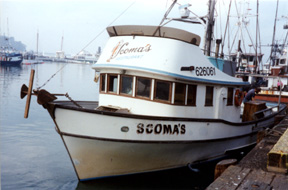 By
Mary Swift-Swan By
Mary Swift-Swan
San Francisco fishermen have a
head start and fighting chance this season to support their
businesses and families. This 2002/2003 season is different from
recent years. Local fishermen have a two-week lead on big fishing
machines from Oregon and Washington. Big boats have huge holds that
enable mass harvest. They begin mass harvest in the San Francisco
region on December 1st, working up the coast following the staggered
seasons of crab migration Local boats take smaller segments out of
pods versus harvesting the whole pod. Local crab are brought in
multiple times a week until the salmon season starts. One might
think consumer prices would go down with larger boats participating.
That did not happen. When free of local competion, the price
doubled. The result is a local fishing economy being squeezed and a
growing concern for longevity and health of the fishing grounds.
This season deserves a close and careful look.
 For
most local boats, following crab north to Alaska is not economically
feasible. Even fishing the waters of Oregon has not been possible
for the local fisherman for two reasons. First, big boats have
greater fuel and hold capacity to work the entire West Coast from
San Francisco to Alaska, staying out for longer periods until holds
are full following the migratory path of Dungeness crab. Only a few
San Francisco Bay Area fishing vessels have the fuel capacity to
work beyond California. Second, it is difficult for California boats
to obtain permits to fish in Oregon waters. The scuttlebutt is that
none of the boats that applied have been granted Oregon permits. For
most local boats, following crab north to Alaska is not economically
feasible. Even fishing the waters of Oregon has not been possible
for the local fisherman for two reasons. First, big boats have
greater fuel and hold capacity to work the entire West Coast from
San Francisco to Alaska, staying out for longer periods until holds
are full following the migratory path of Dungeness crab. Only a few
San Francisco Bay Area fishing vessels have the fuel capacity to
work beyond California. Second, it is difficult for California boats
to obtain permits to fish in Oregon waters. The scuttlebutt is that
none of the boats that applied have been granted Oregon permits.
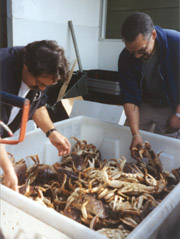 Many
local crab crews worked feverishly during the last off-season,
mending and making serviceable their traps so as to be ready for
this season's start. They’re driven to increase deployment by the
need to remain competitive. It all comes down to midnight November
14th, the moment local fishermen were allowed to set their traps.
Eureka! It turned out to be a good year. Some vessels were in
unloading at the docks by 3 a.m., just three hours later. The
Scoma's Restaurant boat prepared a record 500 traps and after two
days brought in 20,000 lbs of crab. It took hours to off-load,
filling every available box until there wasn't anywhere else to put
the crab. The first of the 2002-2003 season saw the Wharf full of
fresh cooked crab in time for Thanksgiving visitors. What is going
to happen when the big boats begin their harvest on the first of
December? Will locals again buy San Francisco area crab direct from
Portland and/or Seattle or have an option to buy crab from the catch
of San Francisco boats? Many
local crab crews worked feverishly during the last off-season,
mending and making serviceable their traps so as to be ready for
this season's start. They’re driven to increase deployment by the
need to remain competitive. It all comes down to midnight November
14th, the moment local fishermen were allowed to set their traps.
Eureka! It turned out to be a good year. Some vessels were in
unloading at the docks by 3 a.m., just three hours later. The
Scoma's Restaurant boat prepared a record 500 traps and after two
days brought in 20,000 lbs of crab. It took hours to off-load,
filling every available box until there wasn't anywhere else to put
the crab. The first of the 2002-2003 season saw the Wharf full of
fresh cooked crab in time for Thanksgiving visitors. What is going
to happen when the big boats begin their harvest on the first of
December? Will locals again buy San Francisco area crab direct from
Portland and/or Seattle or have an option to buy crab from the catch
of San Francisco boats?
Dungeness crab travel in packs. In
Alaskan waters, a "ball" was reportedly identified that
stretched out a solid mile wide of claw-to-claw crab. Crab have been
tagged and tracked from San Francisco all the way to Alaska. Crab
season in San Francisco ends June 30th. West Coast waters are open
to commercial boats with permits for periods that are predicted to
coincide with the migration pattern as "crab balls" move
north.
The price per pound for crab at the end of the
season flucuated from $2 to $4 per pound. The increased market price
made it worthwhile for the few boats that continued to set traps to
the end of June. We are rooting for the home team to keep the local
market strong and fishing grounds healthy. Good management of San
Francisco fishing grounds is what makes possible banner catches like
those seen with the start of the 2002-2003 season. Now, the
important question: what to do with all that crab?
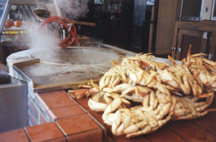 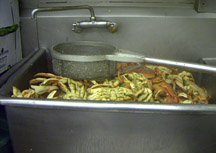 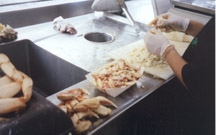
|